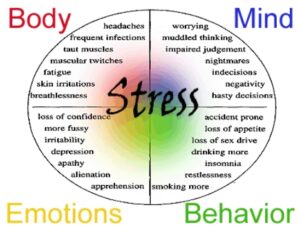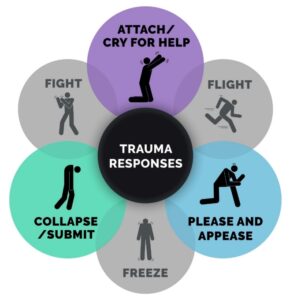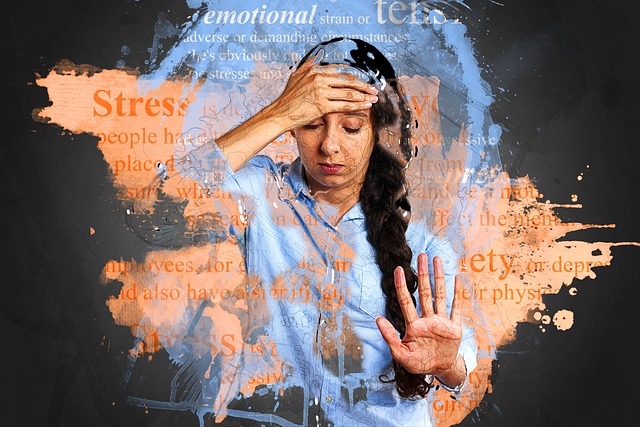Although most people seem to relate to the concept of being “stressed”, what exactly is stress? Neuroscience discoveries are revealing more and more connections between the body and the mind. What happens in our mind can affect our bodies and many cases if it is not addressed it can lead to serious health conditions.
The simple tensing up of muscles starts the fight flight or freeze response when trying to cope with overwhelming negative emotions. If that is not regulated then it continues in that response. What does that response do to the body exactly?
Chronic long -term stress may be normalised by many, but this does not take away from the negative effects of stress on the body such as headaches, fatigue, or even anxiety which otherwise did not originate from the body first, not to mention more serious physical symptoms.
Types of Stress
1) Acute Stress – this is a brief period of stress in response to the demands and pressures of a specific situation, such as an exam deadline, project development, or a specific traumatic event.
2) Episodic Stress – this type of stress means experiencing
acute stress regularly. This repetitive series of acute stress is defined as
episodic, and can relate to really stressful challenges and demand, such as
trying to keep on top of personal debt, being diagnosed with a serious
illness and managing it, or going through a very long process of finalising a divorce or marriage separation, court case etc. When we have episodic stress, we worry endlessly about bad things that may happen, and will become impatient and emotionally drained and/or overwhelmed.
3) Chronic Stress – this is usually a result of ongoing demands, pressures and worries that never seem to end and just pile up and compound- these contribute to the development of chronic stress. This type of stress is especially harmful to our health and wellness, and can negatively affect our work, relationships and quality of life. Those with chronic stress will also tend to adopt a pessimist attitude towards their life.
How does the nervous system cope with Stress?

The Autonomic Nervous System (ANS) is activated from stress triggers.
The ANS includes the Sympathetic Nervous System (SNS) and the Parasympathetic Nervous System (PNS).
Under normal “at rest” conditions – meaning, when not under stress – the PNS takes care of normal physiological activity including regulation of the heart and breathing rates, and increasing the blood flow to the digestive system. The PNS is all about “rest and digest”
The SNS, however is the adaptive system, designed to protect the body from any perceived threats. (note the word “perceived”) The SNS activates the “fight, flight, or freeze” response when a threat is perceived. What happens then is that the body is given instructions to release stress chemicals anticipating the need for action. Then a string of biological actions take place.
The biology response of the nervous system
1. Adrenalin and cortisol levels increase dramatically, producing hypervigilance and hyperarousal;
2. The body gets prepared to either fight or flee including:
• Constricted blood vessels and pupils
• Decreased blood flow to the digestive system
• Increased perspiration
• Increased heart and breathing rates
3. If fleeing or fighting is impossible, the body is prepared to “freeze” through dissociation and leaves the person feeling:
• Detached or disengaged
• Prone to fainting
• Having a changed perception of time as if time is suspended (for example during a car accident when time seems to slow down) “Derealisation may occur, theoretically preparing the body for camouflage, increasing chances for survival through compliance with the attacker, or creating conditions in which death is not as painful if the attacker does not go away” (1)
4. There are other variations of the fight flight or freeze stress response -such as “attach/cry for help”, “please and appease” or “faun” (collapse & submit).

Effects of overactive stress response
Although the SNS stress response is needed for survival, if it is stimulated too often it can harm the body including the regulating functions of the different body systems. The ANS general response is otherwise wired to be triggered in times of stress regardless of whether it is due to physical or emotional pain or extreme fear.
If there is a constant perception of danger causing hypervigilance, this will kick off the autonomic response of alertness to continue to release stress hormones which change the body’s state from relaxed and playful, to fight flight or freeze etc.
Chronic stress activating the ANS response this way causes serious damage to the individual’s physical health (2) “Studies have also shown that cortisol may cause damage to the hippocampus, impairing memory formation.” (3)
And it doesn’t have to be “big T Trauma”- it can be any perceived threat or ongoing “small t trauma”. The trauma response is activated by different stress events in different people; it’s not always the same type of stress event that will produce the same type of trauma response.
Chronic hyperarousal may permanently alter the SNS adrenalin system. Persistent dissociation may alter the opioid (that is, endorphins, the body’s natural morphine) system (Bicknell-Hentges & Lynch, 2009).

Stress response vs personality traits
With ongoing SNS stimulation there is an increased risk -that the state of arousal becomes more stable or structured in the body and mind developing as a trait or part of their personality and way of operating. Basically, the effects of trauma are unresolved and entrenched in the person which shows up in the way they operate on a day to day basis. In extreme cases there may be a labelling of a “mental health disorder” such as Schizophrenia or CPSTD or Borderline Personality Disorder because the symptoms are so severe and entrenched as a trait in the person.
Past Trauma vs Current Stress
When the stress response is triggered- it commonly sets off an alarm in the body-not feeling safe due to perceived danger. This can reactivate the sensations of past traumatic events or distressing events that are associated with similar perceived danger, even if the person has not consciously remembered all the details of the past event.
When people remember an ordinary and insignificant event, they may not necessarily relive the physical sensations, emotions, images, smells, or sounds associated with that event. In contrast, when people fully recall their traumas, they “have” the experience again. They are engulfed by the sensory or emotional elements of the past.
The brain scans of Stan and Ute Lawrence, the accident victims referred to in The Body Keeps the Score, show how this happens.
When Stan was remembering his horrendous accident, two key areas in his brain went blank: the area that provides a sense of time and perspective, which makes it possible to know that “that was then, but I am safe now,” and another area that integrates the images, sounds, and sensations of trauma into a coherent story. When those parts of the brain are knocked out, you experience something not as an event with a beginning, a middle, and an end but in fragments of sensations, images, and emotions. (4.)

Pathways to Recovery
Don’t stress! There IS good news! The effects of stress can be dealt with and resolved via several methods.
1.Changing the environment
Simply by facing and dealing with the actual sources of stress, much if not most or even all of such conditions could disappear including headache, migraine, muscular tension, soreness, and pain, upset stomach, cramps, indigestion, high blood pressure, poor immunity, weakened immune system, insomnia/sleeping problems, anxiety, nervousness, anger, impatience, irritability, short fuse, depression, unexplained feelings of meaningless, fatigue – both physically and emotionally, feeling overwhelmed and out of control, lack of confident and poor self-esteem. Life coaching teaching life skills, counselling using CBT and even art therapy (solutions focused therapies) can assist with this.
2.What if it is not the environment?
That’s all fine if you have some control over your environment and if facing up to the problems and taking action don’t trigger another set of stress triggers! But what if you are having day to day problems dealing with any type of stress and uncontrollably strung out due to chronic stress & overwhelm and unable to make external or internal changes? Instead of general life coaching and life advice, there are a variety of therapy modalities may help you including somatic therapies that improve the healthy connections between the body with with the mind.
3.Dealing with the root cause eg: unresolved past trauma
Somatic therapies dealing with historical unresolved traumas can be effective to change the automatic triggered emotional responses that keep ambushing you. Together with counselling eg CBT or DBT it can be extremely effective to turn things around for the long term. TRTP is especially effective for cutting off the triggers at the root cause and is a gentle therapy that avoids re-traumatising victimhood.
4.Self- awareness and connection with self and others
Understanding what’s happening in our brains and our bodies is the start of therapeutic healing. So often the feeling of “not being normal like other people” only worsens the condition and leads to isolation. We are social beings and need interaction with other people.
Acknowledge what you have been through and how it has affected you with the support of a professional therapist. Reframing the narrative to make it more positive going forward, rather than reinforcing victimhood is also helpful.
Simply reconnecting and talking about those experiences with a trained and compassionate therapist/counsellor/psychotherapist will open up new pathways of dealing with stressors and triggers, and diffusing the biological stress response, instead of being stuck with more of the same as the only known way to react.
5.Rewiring the brain
Brain functions interact with the rest of the body with a variety top- down and down to top signals. It is possible to re- organize “stuck” information through various somatic techniques that turn off the “alarms” eg Neuro Organisation Technique (NOT) or EMDR.
Other techniques use the “window of reconsolidation” in the memory of an unresolved historical trauma to reset or cancel the faulty alarm so it is no longer constantly triggered. Getting to the root cause of why the alarm was created in the first place and replacing it with the body knowing that “it’s over and I am safe now” is extremely effective. TRTP is an all -round therapy for this.
6.Reconnecting mind with body
Long term stress and effects of trauma can “disconnect the mind from the body”. Reconnecting sensations of heart rate, breathing and awareness of the body’s parts and sensations can be achieved in many ways, for example via guided meditation, mindfulness, or somatic techniques such as Embedded Processing to regulate stress responses.
7.Gratitude also has a positive effect on the brain
When we express gratitude and/or receive gratitude, our brain releases dopamine and serotonin, the two crucial neurotransmitters that affect our emotions, and they make us feel ‘good’. They enhance our mood immediately, making us feel happy from the inside. By consciously practicing gratitude everyday, we can help these neural pathways to strengthen themselves and ultimately create a permanent grateful and positive nature within ourselves. (5)
Got Questions?
If you would like a complimentary call to explore therapies to reduce or cope with stress, you can book here: I want to book an introduction call
References
1.Bicknell-Hentges, L, & Lynch, J.J. (2009, March). Everything counselors and supervisors need to know about treating trauma. Paper based on a presentation at the American Counseling Association Annual Conference and Exposition, Charlotte, N.C.
2.Bremner, J.D. (2002). Understanding trauma-related disorders from a mind-body perspective: Does stress damage the brain? New York: W.W. Norton & Company.
3. Sapolsky, R. M. (1996). Why stress is bad for your brain. Science, Vol 273, 749-750.
4. Bessel Van Der Kolk MD, (2014) The Body Keeps the Score pg 254
5. Madhuleena Roy Chowdhury, BA (2019)The Neuroscience of Gratitude and Effects on the Brain

